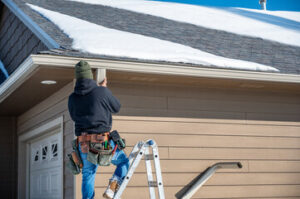Cluttered gutters can damage your home and garden. Cleaning your gutters is an important maintenance task that should be done at least twice a year.

Be sure to use a ladder stabilizer, and wear gloves to protect your hands from the dirt, mold, and debris. Start at a downspout, and work your way across the gutters, scooping up gunk into a bucket or wheelbarrow as you go. Visit Website to learn more.
Clogged gutters can cause significant damage to your home, including water stains on exterior walls and ceilings and even a weakened foundation. The best way to avoid these costly repairs is to schedule regular gutter cleaning services.
The main function of a gutter system is to carry rainwater away from the house. This keeps the soil around the foundation drained properly, preventing erosion and protecting the structural integrity of the building. But when the gutters become clogged, it can lead to the water overflowing and soaking the soil. This can weaken the foundation and create cracks, which can be extremely dangerous for your home.
Stagnant water that accumulates in clogged gutters can also cause mold, mildew, and insect infestation. These problems can cause health hazards for your family and may require extensive clean-up and remediation.
Gutter overflow can also damage the fascia board, window trim, and doors by causing continuous wetness. The excess water can also rot the wood and cause unsightly stains. If you have landscaping, the clogged gutters can flood flowerbeds, erode soil, and sweep away mulch, ruining your hard-earned investment.
When the gutters are clogged, rainwater has nowhere to go except over the side of the house. This can saturate the soil, which can then erode the foundation and cause cracks. Water can also leak through the ceiling and into the attic, causing serious damage to insulation and possible mold growth inside the home.
If you’re concerned about the potential for water damage from a clogged gutter, be sure to document all affected areas as soon as possible. This includes taking photographs and videos of the staining, leaking or water-damaged areas. It’s important to document this as it can be helpful when filing a claim with your insurance company.
As you work to remove the clogs, it’s best to start at one end of the downspout and work your way down. Once you’ve removed as much debris as you can, use a hose with high pressure to flush the remaining sludge down the downspout and into the drain. Be sure to check that the water is coming out cleanly before moving on.
Clogged Gutters Can Cause Mold
Over time, clogged gutters can cause major damage to the exterior of your home. Whether it’s water-related damage to the fascia boards or siding, rotted soffit or drywall, unsightly and expensive roof leaks, or the destruction of your home’s foundation, you’ll be left with costly repairs and restoration bills if you don’t clean your gutters regularly.
Moreover, the stagnant water that can accumulate in clogged gutters provides ideal conditions for mold, mildew, and insects. These organisms can wreak havoc on your home’s structural integrity, and they can also be a health risk for you and your family.
If you see mold, mildew, or insect activity around the edges of your home, it’s a sure sign that your gutters are clogged and need to be cleaned. Stagnant water and debris provide ideal conditions for these organisms to thrive.
Wind and rain carry dirt onto the roof and into the gutters, where it becomes trapped. When this dirt isn’t cleared away, it can clog the gutters, which will cause the downspout to become clogged and overflow. If this continues, it can damage the exterior of your house and soften the soil near your foundation, which can lead to structural problems or even collapse your entire home.
If your gutters overflow, it can also flood your yard and pool against your foundation walls. This can damage or crack your foundation, and it may also cause the basement to flood. In the longer term, it can also create a favorable environment for mosquitoes and other unwanted pests.
Cleaning your gutters is not a job for the inexperienced. It’s best to hire a professional, who can use the proper tools and safety precautions to safely clean your gutters. Start at the spout and work your way down, using a gutter scoop or trowel to clear out leaves, twigs, and dirt from the gutters. Once you’ve removed as much of the debris as possible, use a hose to flush out the remaining debris in the downspout. Make sure the nozzle is on high pressure so you don’t damage your gutters or accidentally clog your downspout.
Clogged Gutters Can Cause Stains
The gutters on your home play a very important role in protecting it, but they can also cause damage if they are not cleaned. Gutters that are clogged can overflow, flood the foundation and even cause mold growth. These problems can be expensive to repair, which is why it is important to regularly clean your gutters to prevent clogs and overflowing.
One of the most obvious signs that your gutters are clogged is when water starts spilling over the sides. This is not only unsightly, but it can also damage your home’s siding and cause stains. Clogged gutters can also cause your roof to leak, which can lead to mold and mildew. The water that flows over your roof can also erode the soil and shingle material, which can weaken your structure.
Standing water in the gutters can also attract pests, which can damage your property. In addition, the moisture can trigger allergies and asthma in your family. Finally, the stagnant water can encourage fungus to grow, which can further damage your property.
Gutter cleaning is not the most fun task to do, but it is essential. If you’re not careful, your gutters can become clogged with leaves, twigs, and dirt. Clogged gutters can overflow, which can damage your home’s foundation, shingles, and siding. In addition, they can also lead to a host of other problems.
Keeping your gutters free from debris is essential for the health and appearance of your home. If you notice that your gutters are clogged, it’s time to call a professional. When you hire a professional, make sure they follow proper ladder safety procedures. They should also use a ladder that is sturdy and safe for their height. Also, they should wear work gloves and use a high-powered hose to clear the debris in the gutters. This will ensure that the debris is completely removed from your gutters and that it won’t re-clog your system. Once the clog is cleared, your gutters will be able to drain properly, which will protect your home from damage and prolong its lifespan.
Clogged Gutters Can Cause Damage to Your Roof
When your gutters become clogged with leaves, dirt, twigs and other debris it makes it impossible for water to safely flow through them. This prevents your guttering from doing its job which is to direct rainwater and snowfall away from the foundations of your home and into the landscaping around your property. Clogged gutters can cause a number of serious problems that can be very costly to fix if left unchecked.
One of the biggest issues associated with clogged gutters is the fact that it can lead to roof damage. When the shingles are exposed to water without an escape route they may begin to rot and crack. This can also lead to leaks which can cause major interior damage if left unchecked. In the long term, roof leaks can also cause damage to fascia boards and soffit materials, requiring expensive repairs or even a full replacement.
Another potential problem associated with clogged gutters is that it can create a breeding ground for pests. Mosquitoes, flies, wasps and other insects are attracted to the stagnant water and debris in clogged gutters and can become a real nuisance. If they have easy access to the inside of your home they will be able to breed and infest your living space, leading to numerous health issues for you and your family.
Finally, a clogged gutter can cause damage to your landscape. As water flows over the top of your clogged gutters it can spill out and flood flower beds and shrubbery, washing away mulch and drowning plants in excess water. This can also cause erosion which can lead to a damp basement or foundation problems in your home.
In winter, clogged gutters can also create ice dams which can be very damaging to homes. They form when snow begins to melt and then refreezes, blocking the gutter flow. This can damage the fascia boards, soffit and shingle materials, leading to leaks and general weakness in your roof structure. The best way to protect your investment and avoid these potential problems is to ensure that your gutters are free from blockages by having them cleaned regularly.



